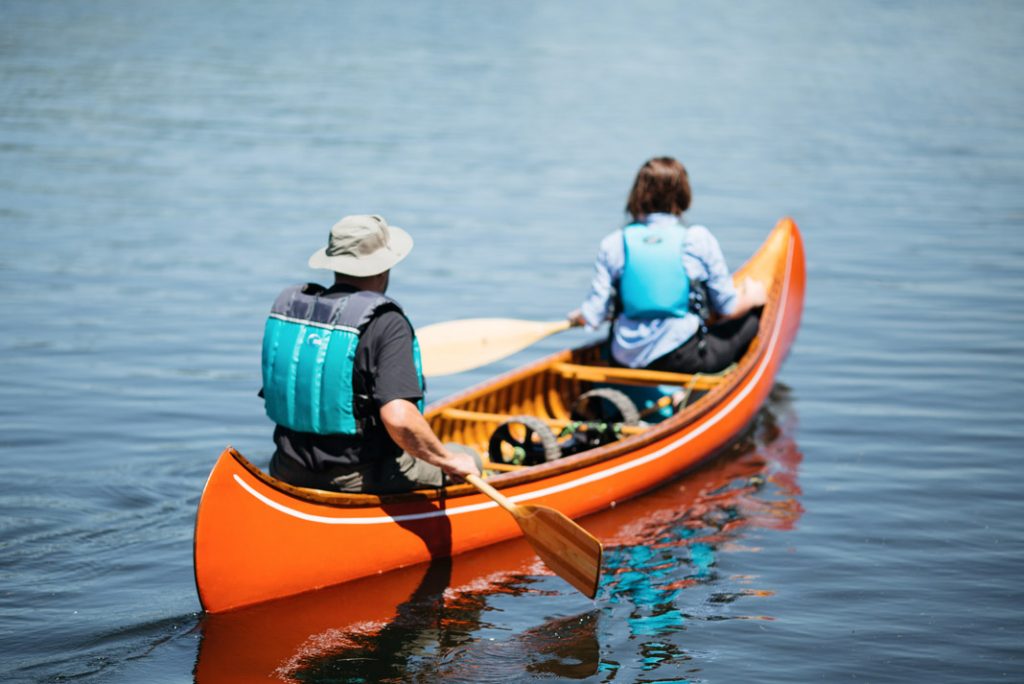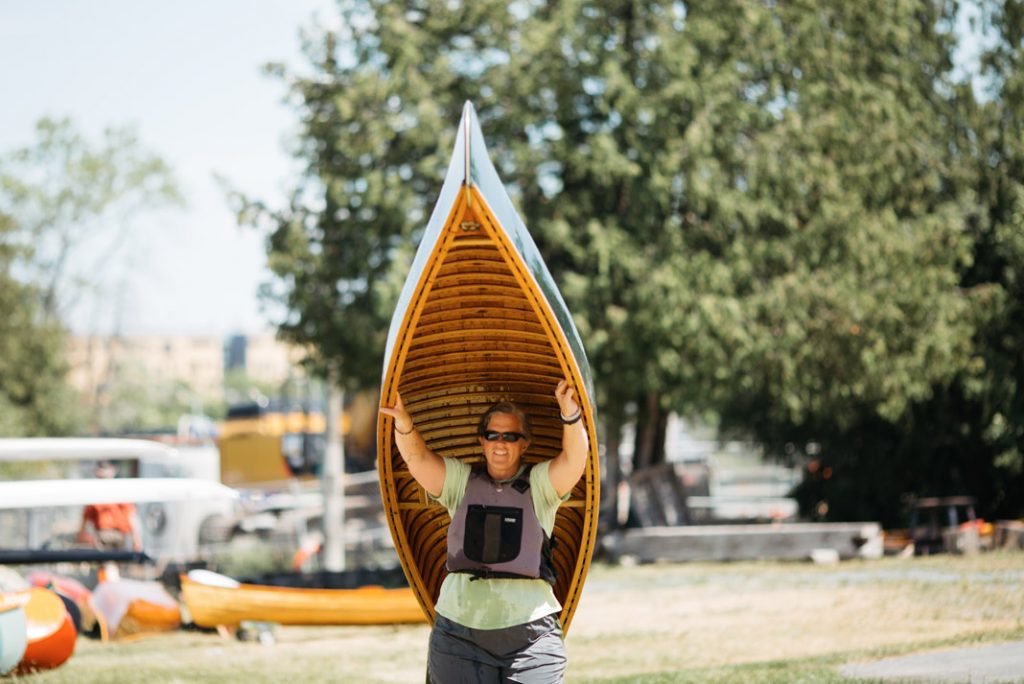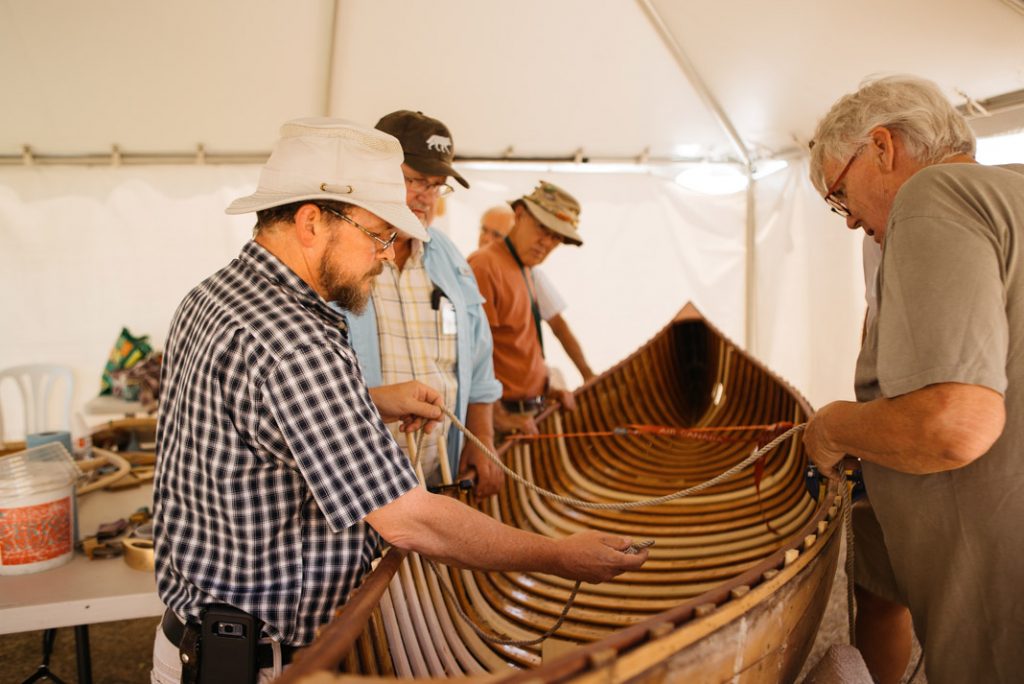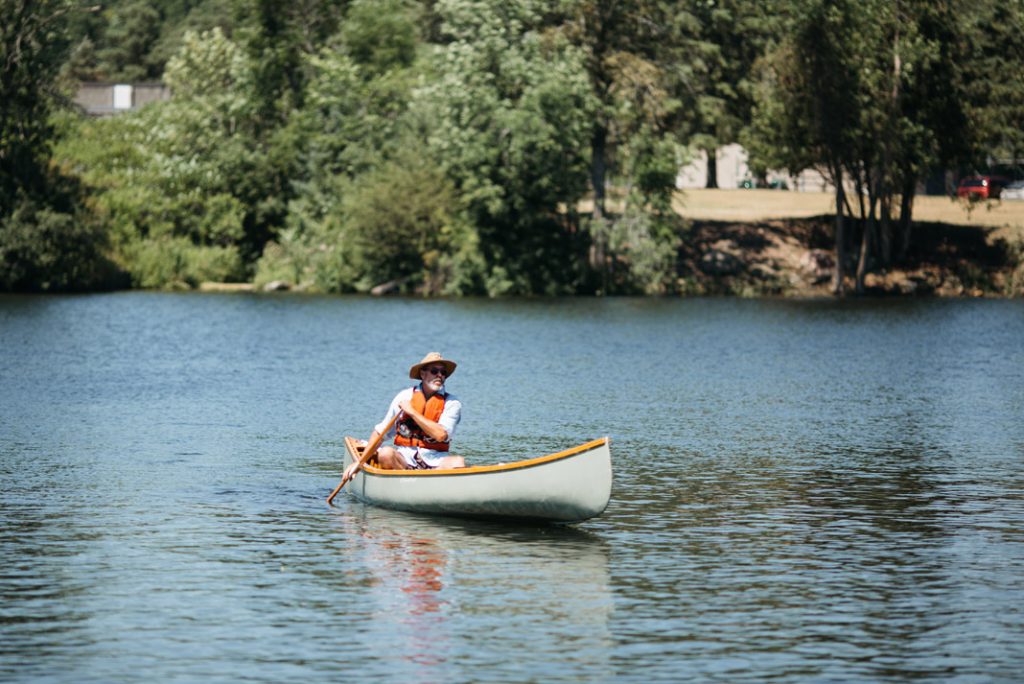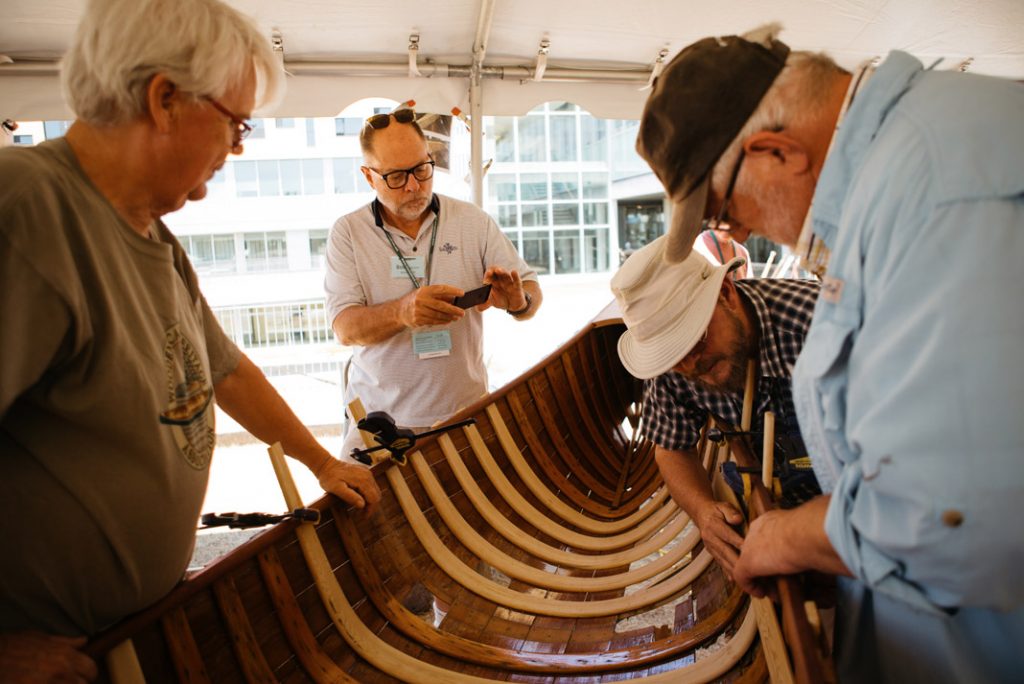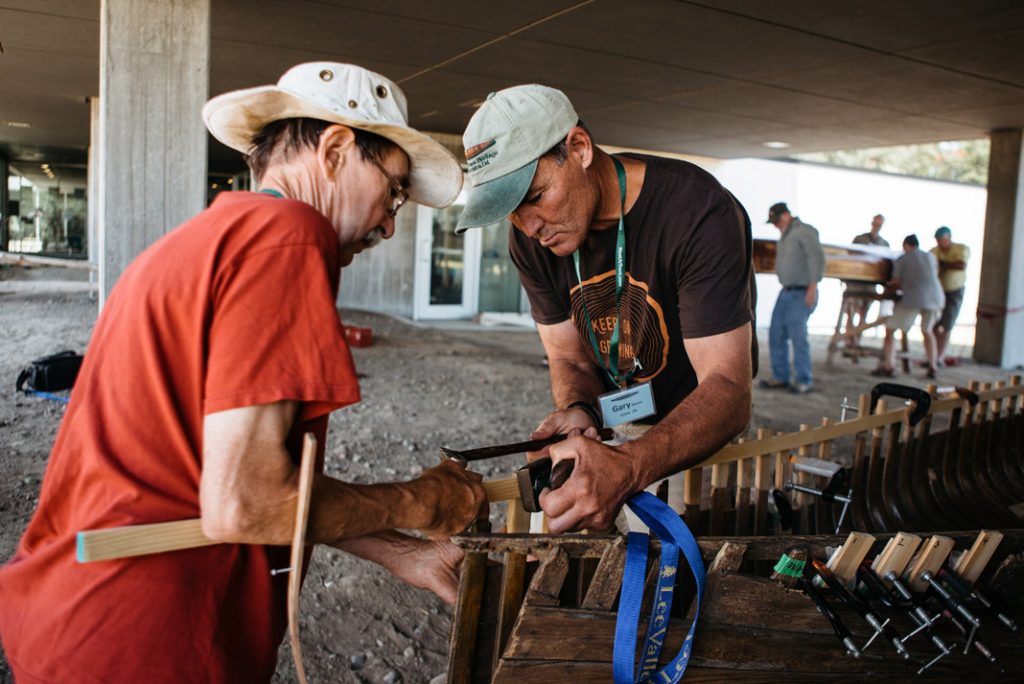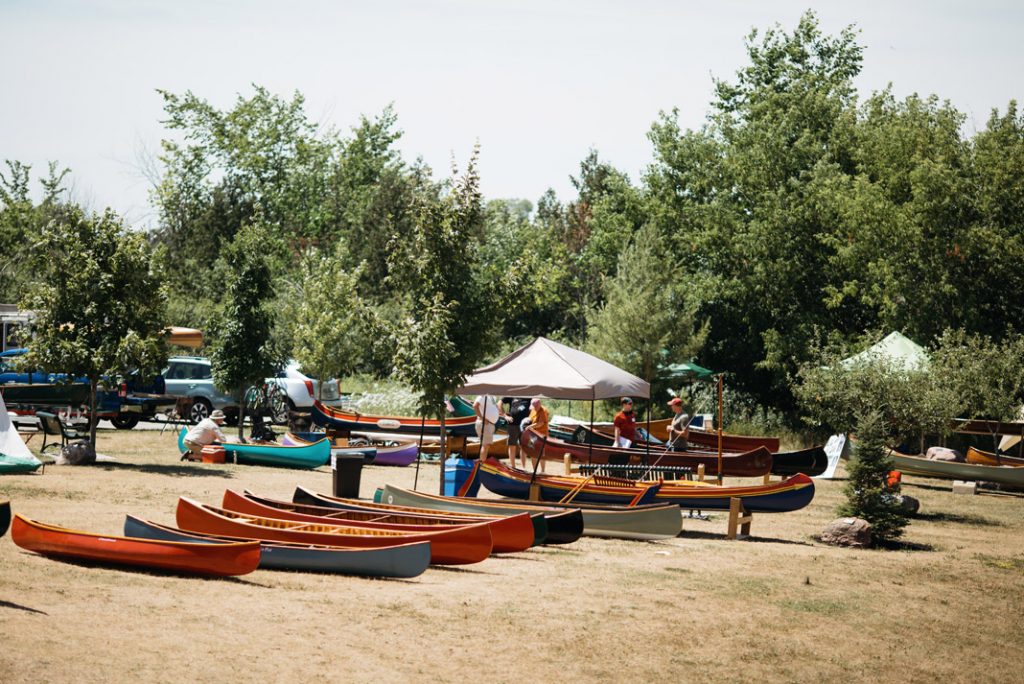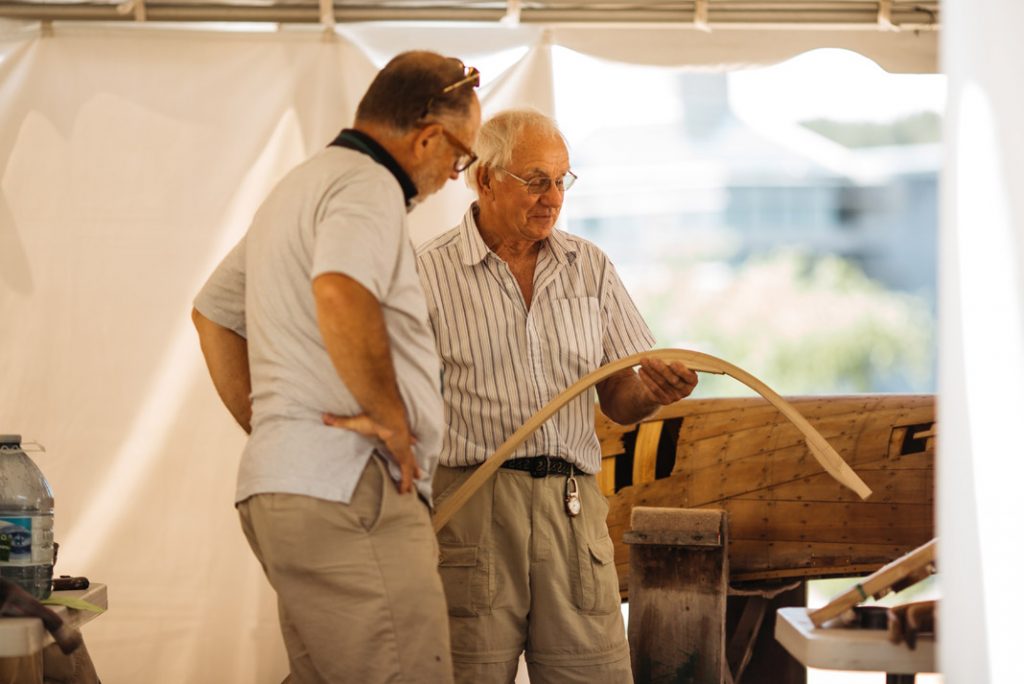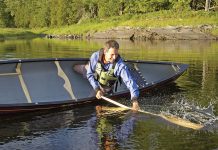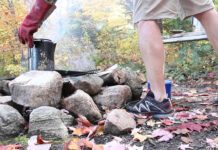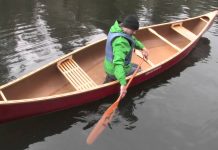Under the shade of a white tent a man sits on a stool and threads rattan cane material through the holes of the wooden canoe seat frame he holds on his lap.
Beside him another man leans in toward a shavehorse. The rustic workbench clamps in place a length of wood. It looks more like a paddle with each pass of his spokeshave. At his feet, the peels of hardwood are piling up, evidence his tool is sharp and in expert hands. All around the dusty yard, wooden canoe hulls sit in cradles, ready to have planking tacked on, gunwales attached or canvas stretched overtop.
The Wooden Canoe Heritage Association
The scene could be from 1895, except for the garish, 21st century backdrop of the six-storey Peter Gzowski College building on the grounds of Peterborough’s Trent University.
The Peterborough Canoe Company started making cedar canvas canoes in this south-central Ontario town in 1892. And though the iconic manufacturer went out of business nearly 60 years ago, it’s here the Wooden Canoe Heritage Association (WCHA) held its annual assembly last July to honor the venerable brand.
The WCHA is an American organization dedicated to the preservation, restoration and use of wooden canoes. More than 200 of its 1,435 members made the trip to the annual event—held in Canada for the first time since sometime in the ‘90s—and most of the attendees hail from the United States, many from as far away as Florida, Colorado and Texas.
This year, the WCHA turns 40. Despite a slowly dwindling membership, its affiliates are passionate. These are people who love everything about wood canoes—they love paddling them, building them, restoring them and, yes, talking about them.
I’ve long held an appropriate reverence for the classic cedar canvas style. However, I’m guilty of thinking of it only as a charming step in the evolution of canoes.
If the popular view of cedar canvas canoes is their day has mostly passed, the WCHA is here to correct the notion. In every workshop, demonstration, display and discussion, one theme runs as clear as western red cedar grain—the utter resiliency of these designs and this material marks a high point of evolution. And despite the rich history of each design, they never have to become mere museum pieces.
When I arrive on Friday, day three of the five-day event, the Annual Assembly is well underway. Under a hot July sun, a row of a dozen canoes sit upright on the drought-stricken grass landing area at the Peterborough Rowing Club. Their owners have left them here to be admired following the morning’s paddle down the Otonabee River and through Peterborough’s famous lift locks.
The rich amber hue of aged but gleaming varnish marks most of the hulls as old but well-tended. One has the name Tiger Ray emblazoned on its side and another has a small flagpole and flag on the stern deck. Most, though, seem to flaunt a look of unadorned dignity, suggesting the simple aesthetic of the canoe needs no improvement.
One hull stands out from the rest. The wood is blond, fresh and its exterior is shiny and smooth to the point of looking like pristine gelcoat. Which would, of course, be a grave insult to Alex Combs, the man who sanded, painted and varnished the cloth-covered hull five times in his workshop to create the gleaming finish.
Combs identifies himself as belonging to the mind-your-own-business camp of wooden canoe builders and restorers
It takes only a little encouragement to prod Combs into talking about his boat. He allows the hull doesn’t actually use canvas as its shell material. Instead of stretching a sheet of canvas over the planked hull, he used Dacron, a polyester fabric sometimes used as sailcloth.
As for the filler, the concoction of resins and compounds impregnating the Dacron makes the canoe watertight. “I’d say that’s a secret,” answers Combs coyly.
And with that Combs identifies himself as belonging to the mind-your-own-business camp of wooden canoe builders and restorers who have developed what they consider to be secret recipes of the best-performing filler ingredients.
Those in the other camp are not so concerned about the hours and brain cells devoted to perfecting ratios and cure times and are all too eager to talk all about it, at length, to anyone who will listen. In essence, connecting these people, through the WCHA’s busy web forums, bimonthly newsletter and events is what the association is all about.
Building professionally since 1979, Combs is one of the association’s earliest members. As such, he has a good sense of the sweep of the 40-year history of the WCHA.
“When aluminum and fiberglass canoes hit the market they almost obliterated the wood canvas canoes,” says Combs, pointing to the line of canoes on the grass, many of them older than my four decades. “These became relics.”
“The organization and the people in it dug out these old ones. Like me, they felt a passion for revitalizing them, for bringing them back to life. Together, we created some energy.” Combs says it takes about 130 hours to make a new canoe out of his shop, Stewart River Boatworks, in Minnesota. But he concedes, most of the work is not in new construction but in restoration of mid-20th-century hulls.
To Combs, wood construction does not entail a sacrifice in performance. The Dacron-shell hull he now swings over his head to put on his car’s roof racks weighs only 52 pounds.
There is a difference in how it sounds. When you put your paddle down in a wooden boat, it just sounds, and feels, right
A lot of people think they are delicate,” he says as he firmly cinches down a strap. “That’s just not the case. I’ve never broken a rib, and I’ve hit a lot of rocks.
“The aesthetics propel most of the interest,” explains Combs, but then hints at a blurring of the line between aesthetics and performance. “Most people who have been in a wooden canoe know there is a different feel. There is a difference in how it sounds. When you put your paddle down in a wooden boat, it just sounds, and feels, right.”
When it comes down to it, it seems self-evident wood should be the preferred material for making a canoe, Combs adds. “Wood encapsulates air. It floats. Metal and fiberglass don’t do that.”
While Comb’s unblemished, 52-pound Dacron hull exemplifies the current state of wooden canoe building, much of the grunt work in the WCHA is devoted to what’s happening in an open air breezeway under the student residences back on the Trent University campus.
Pam Wedd, a builder from near Parry Sound, Ontario, has an overturned hull up on workhorses and about 20 onlookers shuffling, politely but intently, for space around it. The session is advertised as a demonstration of how to stretch canvas over a hull, probably the single most momentous step in any new build or restoration.
However, there is some discussion as to whether the hull is smooth enough for this next step. A few eagle eyes in the group see a protruding tack head here; a plank with a raised corner there.
“It’s ever changing,” says Wedd. “The humidity today is different from a week ago when I faired it. Let’s not fuss. Every builder has different fussiness levels,” Wedd explains to me, in a voice loud enough for most to hear. “Though, this crowd as a whole tends to be on the fussy side,” she says, only slightly lower.
Visions of Phil Hartman’s 1990s Saturday Night Live character, the Anal Retentive Carpenter, come into mind. “We sometimes have interventions before sessions to establish fussiness levels,” jokes Tim Sampsel. He’s a woodworker from Colorado, crossing over from whitewater paddling, and here to learn some particulars of boat building in order to maintain a few wooden canoes his wife owns. He’s sure to leave with a boatload of tips and tricks about how to coax flat pieces of wood into particular canoe shapes.
As the flat sheet of canvas is unfolded and laid over the almost perfectly smooth hull questions arise about materials, techniques and tools. Wedd rarely gets a chance to answer before someone in the group offers advice from their own hours spent in home workshops.
Now that I’m retired, I’m trying to relive the 1950. Time was slower then. When I drive, I take the back roads. It’s the same thing with canoes
The canvas is stretched and pulled down over the canoe by a come-along pulley winch beyond the bow and stern. Volunteer pairs with vice clamps and staple guns begin securing the canvas to the hull where the gunwales will eventually attach.
“I would have used tacks,” says bystander Roy Nunelly under his breath to no one in particular and anyone who can hear.
I ask if his preference for brass tacks could be attributed to them securing the canvas better than staples, or just to them being the traditional fastener.
A bit of both, he says, though the Texan admits he can be a stickler for the traditional ways. “I once drove to Maine so I could get inwales that matched my outwales.”
When I ask him why such an attention to detail he takes the long view. “My first canoe was wood canvas. Now that I’m retired, I’m trying to relive the 1950s. Time was slower then. When I drive, I take the back roads. It’s the same thing with canoes.”
I’ve restored six already, have three more to go. It’s so relaxing for me to say, ‘I don’t care about the yard work, I’m going to work on my canoe.’ Then I go to my shop and pick up my hand tools.
I ask if Nunelly thought the hull was smooth enough to canvas and he explains how a layer of canvas hides a lot of imperfections, and admits he’s been guilty of using an iron to steam and swell the wood around a tack where a misplaced hammer strike had dented the wood during construction.
Craig Johnson, standing nearby, leans in to politely one-up Nunelly’s iron story. “I once had to use a blowtorch,” he says.
As much as these canoes are now obsessed over and coddled, most of them came into being as mass-produced, factory-made utilitarian craft. They’ve come to be seen as works of art, but their origin story is somewhat plainer. In a factory, sanding might not have been done by hand but instead by two men rolling a canoe back and forth over a huge sanding belt running the length of a canoe.
That sort of aggressive sanding left the tack heads on Johnson’s 1960s-era Peterborough Mermaid canoe a little proud, he says. To a woodworker, proud is problematic, referring to anything protruding above a flat surface.
“I couldn’t have proud tacks for the sake of the paint job,” explains Johnson. “But re-clinching [pounding in] the tacks would leave dents from the hammer.”
It’s the restorer’s burden to remove these hammer tracks, and they do it by steaming the compressed wood until it swells back to flat. But Johnson couldn’t steam the wood because it had been slathered in linseed oil, closing its pores.That’s where the blowtorch came in.
I ran into the shore, because I was looking down at how beautiful the canoe was
With some trepidation, Johnson started singeing the 50-year old cedar planking. It’s a process he wrote about in an article entitled “When Will I Learn to Leave Well Enough Alone,” in the February, 2018 issue of Wooden Canoe, the association’s bi- monthly magazine.
Despite the ominous title, he managed to burn off the oil and not much more. Though it was a messy job, he was then able to set all the tack heads, steam the dents and sand the whole hull, only losing 1/32 of an inch of hull thickness.
Johnson is a former cabinetmaker and housepainter from Ohio. He inherited his first wood canoe from his outdoorsman father. After restoring it he took the canoe out for a paddle on a small pond.
“I ran into the shore, because I was looking down at how beautiful the canoe was,” he laughs. Then he started collecting.The blowtorch canoe brought his collection up to 17.
When asked if he prefers working on them or paddling them, he provides a thoughtful answer. “That’s why we have winter and summer. I love the work, but I’m getting to the point where I just want to get out more and more.”
He was planning a late summer trip to Ontario’s Quetico Provincial Park with a 14-foot Peterborough for a solo eight-day. He’s been there before, once in his father’s old canoe and once in a 17-foot Kevlar model, a craft, he says, diminished the experience. “So I’m going back, and this time it’s about me and the boat,” he says.
On a plastic boat, nothing sticks to it. But on a wooden boat like this, there are no parts you can’t replace
The two-pronged appeal of the craftsmanship and the crafts themselves has to be seen as a strength of the WCHA, two strong draws the association can rely on to keep members interested, but even so the group is facing serious challenges from the formidable foes of demographics and technology.
Annie Burke is the association’s executive director and treasurer. She’s waiting outside a university lecture room before the board of directors convene for a meeting. Comfortably in middle age, she represents the younger wing of the organization.
“We have more than 1,400 members, but we once had 2,100,” she says. The organization has no doubt benefitted from the pull of nostalgia, but nostalgia can be time sensitive.
“A generation grew up with these canoes being commonplace,” she says. When the association was founded in 1979, the heyday of the cedar canvas canoe was still in recent memory for many.
But that generation is moving through time to a hard deadline.
Additionally, the Internet has eroded the necessity of someone needing to belong to a group like the WCHA in order to be connected to like-minded people and learn the tricks of the trade.
“Young people don’t join clubs like they used to. They can find people online without joining and spending $40 per year,” says Burke. But she hopes to counter technology’s disruptive effect with technology itself.
“Our next foray is to be more active on Facebook and Instagram,” she says. “As my daughters tell me, our boats are very Instagrammable.”
If I’m going to put in the effort, it’s going in the water
Not all of the crafts are so worthy of Insta-fame, however. On the lawn in front of the silent auction table is a canoe that has seen better days. Probably many decades of them.
It’s not the classic rib and plank design but something closer to a dugout in appearance, with low shear lines and not a hint of tumblehome or any of the other sexy curves flaunted by the other canoes on display.
A quick scan shows seven holes in the hull and a broken gunwale.
Floyd Reid is interested. He says he has one at home in North Carolina that’s worse. He starts to refer to this hull-like thing as a project.
I ask if he has a well-equipped shop. He replies that he restores railroad trains. I consider him and his shop—the North Carolina Transportation Museum—qualified.
I ask if the canoe will be a museum piece or something he actually paddles. “If I’m going to put in the effort, it’s going in the water,” he reassures.
All of a sudden the canoe doesn’t look quite so decrepit. Something about the way Reid keeps running his eyes over it tells me, because of these people, the spirit of this gathering, a boat like this doesn’t just have a lengthy past—an unknown past of sunset paddles, regatta races, fish caught, headwaters fought—but also a future.
The guiding vision might have been summed up best by Dave Alguire, a member of the Wooden Canoe Builder’s Guild who was working on a canoe on which the top of every rib was rotted away, going about replacing the rib ends one at a time: On a plastic boat, nothing sticks to it. But on a wooden boat like this, there are no parts you can’t replace.
This article originally appeared in Issue 56 of Paddling Magazine. Subscribe to Paddling Magazine’s print and digital editions here, or browse the archives here.
It’s about the satisfaction when it all comes together. | Feature photo: Heather Coughlin





